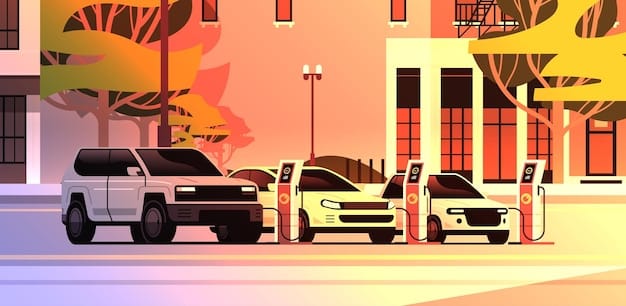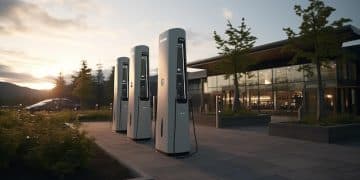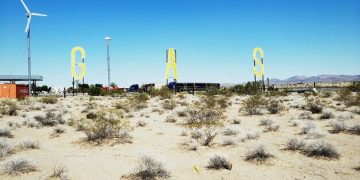EV Charging Infrastructure Growth: Impact on US Energy Demand by 2028

The expansion of electric vehicle (EV) charging infrastructure in the US is poised to significantly increase energy demand by 2028, requiring strategic grid upgrades and potentially shifting energy consumption patterns to accommodate the surge in EV adoption.
The electric vehicle (EV) market is accelerating, and with it comes a crucial question: how will the growth of electric vehicle (EV) charging infrastructure impact US energy demand by 2028? The answer is complex and will shape the future of energy consumption in the United States.
The Electric Vehicle Revolution: A Charging Challenge
The transition to electric vehicles is well underway in the United States. As more consumers opt for EVs, the demand for charging infrastructure escalates. This growth presents both opportunities and challenges for the country’s energy grid and overall energy consumption patterns.
Understanding the implications of widespread EV adoption on energy demand is essential for policymakers, energy providers, and consumers alike. Strategic planning and infrastructure investments are necessary to ensure a smooth and sustainable transition.
EV Adoption Rates and Projections
The rate at which EVs are being adopted plays a crucial role in projecting future energy demand. Factors such as government incentives, technological advancements, and consumer preferences all influence the pace of EV adoption.
Analyzing current trends and making informed projections are essential for preparing the energy infrastructure for the coming surge in EV usage.
- Government incentives, such as tax credits and rebates, significantly encourage EV adoption.
- Technological improvements, including longer battery ranges and faster charging times, make EVs more appealing to consumers.
- Consumer awareness and environmental consciousness are driving demand for cleaner transportation options.
Ultimately, the rate of EV adoption will dictate the scale of the impact on US energy demand by 2028.
Current State of US Energy Consumption
To understand the potential impact of EV charging on energy demand, it’s crucial to examine the current landscape of energy consumption in the United States. This overview provides a baseline against which the added demand from EV charging can be assessed.
Currently, the US energy mix is diverse, relying on a combination of fossil fuels, nuclear power, and renewable sources. Understanding this mix is vital for evaluating the sustainability of increased EV charging.

Breakdown of Energy Sources
The US energy sector is complex, with various sources contributing to the overall energy supply. Each source has its own implications in terms of environmental impact and sustainability.
The transition to EVs could potentially shift the balance of energy sources, depending on how the increased demand is met. It will be important to understand the differences and how the shift will occur.
- Fossil fuels, including coal, natural gas, and petroleum, currently make up a significant portion of the US energy mix.
- Nuclear power provides a substantial amount of baseload electricity.
- Renewable energy sources, such as solar, wind, and hydropower, are increasingly contributing to the energy supply.
The current state of energy consumption will shape how the grid adapts to increased EV charging demands.
Growth of EV Charging Infrastructure: Projections to 2028
The anticipated growth of EV charging infrastructure across the US is a critical factor in assessing its impact on energy demand. This includes both the number of charging stations and their geographical distribution.
Various projections suggest a rapid expansion of charging infrastructure to support the growing number of EVs on the road.
Public vs. Private Charging Infrastructure
The deployment of EV chargers can be categorized into public and private infrastructure. Each type plays a unique role in meeting the charging needs of EV owners.
Understanding the dynamics between public and private charging is essential for effective planning and resource allocation.
- Public charging stations offer convenience for on-the-go charging and are essential for long-distance travel.
- Private charging, mainly at residential locations, provides convenient overnight charging options for EV owners.
- Workplace charging is also growing, offering employees the opportunity to charge during work hours.
The blend of public and private charging will determine how energy demand is distributed and managed.
Impact on the US Power Grid
The influx of EVs and their charging demands will significantly impact the US power grid. Grid operators must prepare for increased load and ensure reliability during peak demand periods.
Upgrading and modernizing the grid are essential steps to accommodate the increased electricity demand from EV charging.

Grid Upgrades and Modernization
Modernizing the power grid involves implementing smart grid technologies, enhancing grid resilience, and expanding transmission capacity.
These upgrades are essential to handle the fluctuations in demand caused by EV charging and ensure a stable electricity supply.
Strategic investments in grid infrastructure are necessary to accommodate the growing number of EVs.
Opportunities to Mitigate Energy Demand
Several strategies can be employed to mitigate the impact of EV charging on energy demand. These include smart charging, vehicle-to-grid technology, and renewable energy integration.
Adopting these strategies can help optimize energy consumption and reduce strain on the grid.
Smart Charging and Vehicle-to-Grid Technology
Smart charging involves managing the timing and rate of charging to avoid peak demand periods. Vehicle-to-grid (V2G) technology allows EVs to feed energy back into the grid, providing additional flexibility.
These technologies can play a crucial role in balancing energy supply and demand.
Smart charging can shift EV charging to off-peak hours, reducing the strain on the grid during peak times.
Policy and Regulatory Considerations
Government policies and regulations play a significant role in shaping the growth of EV charging infrastructure and managing its impact on energy demand. Incentives, standards, and regulations can all influence the development of the EV market.
Clear and consistent policies are essential for promoting EV adoption and ensuring sustainable energy practices.
Government Incentives and Regulations
Tax credits, rebates, and emission standards can encourage consumers and manufacturers to adopt EVs. Regulations related to charging infrastructure can ensure safety and accessibility.
These policies can accelerate the transition to electric vehicles and promote efficient energy use.
The effectiveness of government policies will be a key factor in shaping the future of EV charging and energy demand.
| Key Point | Brief Description |
|---|---|
| ⚡ EV Adoption | Increasing EV adoption rates drive higher electricity demand. |
| 🔌 Charging Infrastructure | Expansion of public and private charging stations is essential. |
| 💡 Grid Modernization | Upgrades are needed to handle increased loads and ensure reliability. |
| ♻️ Renewable Integration | Integrating renewables reduces the carbon footprint of EV charging. |
Frequently Asked Questions
▼
Estimates suggest a significant increase, potentially adding several percentage points to total US electricity consumption, depending on EV adoption rates and charging patterns.
▼
Strategies include smart charging, V2G technology, renewable energy integration, and grid upgrades to manage and balance the increased demand effectively.
▼
Both will expand, with public stations growing along major routes and private charging becoming standard in homes. Workplace charging will also likely see an increase.
▼
Incentives such as tax credits and rebates will continue to drive EV adoption, impacting energy demand by making EVs more affordable and accessible to consumers.
▼
Integrating solar and wind energy can create a cleaner charging system, reducing the carbon footprint of EVs and promoting sustainable energy consumption.
Conclusion
The growth of electric vehicle (EV) charging infrastructure will undoubtedly have a substantial impact on US energy demand by 2028. Addressing this challenge requires strategic planning, investments in grid modernization, and the adoption of smart charging solutions. Policies promoting renewable energy integration will be essential to ensure sustainability.





